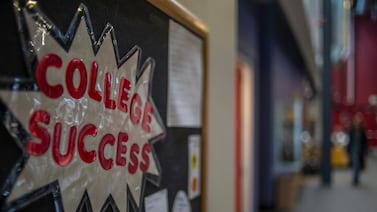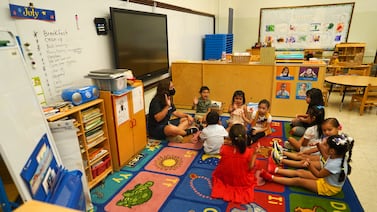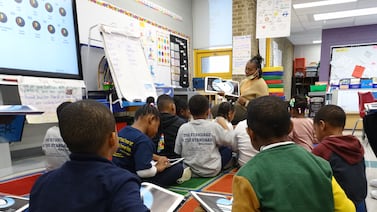Philadelphia school officials defended the use of window fans to improve air circulation in classrooms Tuesday, but stressed the measure is just one of several being taken to mitigate the spread of COVID-19.
The fans are meant to supplement the “core preventive measures” recommended by the CDC, namely masks and social distancing, said district chief operating officer Reginald McNeil at a briefing for reporters. “We put all these things in place. We added an additional layer of protection with ventilation to help further prevent the spread of COVID,” he said.
Officials’ defense of the fans comes as a growing chorus of parents and teachers questioned the district’s installation of window fans to improve air circulation ahead of staff returning to schools on Monday, Feb. 8. About 9,000 students from pre-kindergarten through second grade who have elected to attend in-person school two days a week in the hybrid learning plan are scheduled back on Feb. 22.
The critics have shared pictures of the fans on social media and contended fans can even be dangerous by spreading the virus instead of containing it. A parent-organized petition on change.org to scrap the reopening has garnered 3,000 signatures.
McNeil said that the district chose fans as its primary method of improving ventilation over more expensive air filtration units, which experts say are more efficient in removing pathogens.
He said 3,000 fans have been purchased, and 34% of them installed, and promised the rest would be in place by the time staff is expected to return on Monday Feb. 8. He also said that Hite was mistaken when he told board of education members at Thursday’s meeting that the fans could measure air flow in real time. “They do not have a gauge to measure air flow,” McNeil said.
Industrial hygienists and ventilation experts consulted by Chalkbeat said window fans that recirculate indoor-outdoor air, if used properly, are a common way to dilute pathogens. But they added that the fans won’t by themselves bring classrooms up to ventilation standards for pathogen control required in hospitals, for instance.
“In most non-health care settings that were never designed to do this, never intended to control infections. … You’re never going to be able to modify those sufficiently to achieve that type of performance,” said industrial hygienist David Krause. He said filtration is more effective, but the district has not chosen that option.
Still, said McNeil, in the 10 months since the pandemic shut schools last March, the district has done a lot of work on classroom ventilation.
Where it could, the district upgraded long-neglected mechanical ventilation systems, citing four schools where this has been done. But to completely overhaul ventilation in all the district’s buildings, which are on average 75 years old, would require “a large capital effort” well beyond the district’s means. Plus, he said, it would take years to do.
“Our mechanical ventilation systems are extremely antiquated,” McNeil said, adding later, “We have to work with what we have.”
After system upgrades, the second option “is to bring in fresh air,” he said, adding that the district is now looking at air purifiers for filtration. Regarding worries that fans would spread the virus instead of containing it, he said they would be placed in windows furthest from people and, where the type of window allows it, would be tilted upward.
The district remains confident that the two options — mechanical repairs in some schools and the fans in most of the others — “will accomplish the goal,” McNeil said.
At a webinar arranged by Penn Environment and other groups, Jerry Roseman, the environmental adviser to the Philadelphia Federation of Teachers, questioned the fan solution and said the district did not adequately coordinate with the union or parents.
“If teachers and students don’t feel safe, teaching and learning can’t happen,” he said. “There needs to be...open sharing of data and information in ways that can be understood, questioned, analyzed and used …That hasn’t happened.”







